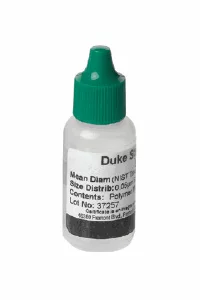[annasta_filters preset_id=1]
OptiBind – Hydrophobic Polystyrene Latex particles
OptiBind Microspheres with Hydrophobic Polystyrene
OptiBind Micro-Spheres, Maximum Diagnostic ReactivityOptiBind Polystyrene Spheres, PSL particles, are used right out of the bottle for maximum reacti…
In stock
OptiBind Microspheres with Hydrophobic Polystyrene
OptiBind Micro-Spheres, Maximum Diagnostic Reactivity
OptiBind Polystyrene Spheres, PSL particles, are used right out of the bottle for maximum reactivity in many diagnostic applications, and can be used in turbidimetric and nephelometric assays, slide agglutination assays, chemiluminescent assays and in clinical diagnostics and molecular biology applications. No surfactants are used, such as SDS, Tween 20 or Triton X-100, which can interfere with protein binding to particle surfaces. OptiBind Polystyrene surfaces are hydrophobic and absorb proteins almost instantaneously. Our proprietary anionic surfactant does not interfere with the binding of proteins nor cause proteins to desorb from micro-particle surfaces. OptiBind PSL material is available from 0.1 μm to 2.5 μm size diameter. The key advantages of the OptiBind polystyrene particles are no pre-washing, a tight size distribution of CV <2% and optimized colloidal stability. Shelf life is a typical 10 years. The Microparticle Reagent Optimization manual outlines our reagent development strategy. This manual includes validated binding, coupling and particle reagent optimization protocols. Click on the Microparticle Reagent Optimization manual link.
Applications: Opti-Bind particles particles have been optimized for maximum reactivity in many diagnostic applications, and can be used in turbidimetric and nephelometric assays, slide agglutination assays, chemiluminescent assays and in clinical diagnostics and molecular biology applications.
Additional information
| Model | Default Title |
|---|



